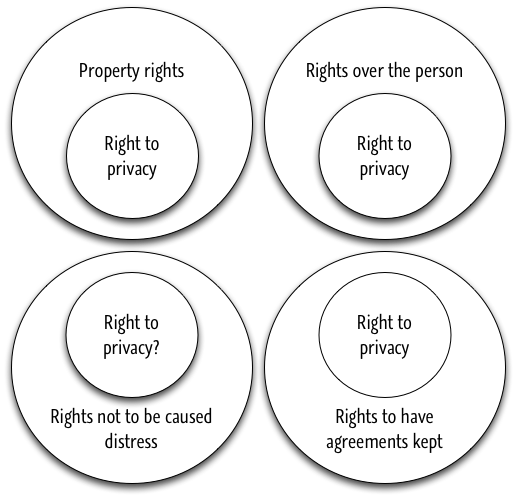Main points
- Thomson’s simplifying hypothesis.
- What you think about Thomson’s right not to be looked at.
We talked about Thomson’s “simplifying hypothesis” that the right of privacy is not a distinct right on its own but is rather protected by other rights.
Here’s an illustration of the simplifying hypothesis: privacy shows up as a subset of other rights. The hypothesis is that it only shows up within other rights and never on its own.

You might ask, “so what do all the little privacy circles have in common, such that it makes sense to use the same word for them?” I think Thomson would say that there is no illuminating answer to that question. The simplifying hypothesis simplifies the right to privacy by giving up on the attempt to identify a distinct, unified right to privacy. Since everything we’re inclined to call part of the right to privacy is already protected by some other right, there is no need to bang our heads against the wall of saying what, exactly, the right to privacy involves and why it is valuable.
If she is correct, then considerations about privacy don’t really explain why we have any of the rights that we do. You have the right to privacy because you have property rights, rights over your person, and so on. You don’t have those other rights because you have the right to privacy (Thomson 1975, 312–13).
Even though she despairs of a unified theory of privacy rights, Thomson does think there are some useful generalizations. For instance, some of the rights that make up what we loosely call the right to privacy are rights that limit how others can acquire private information (Thomson 1975, 307–8) while others are rights governing how others can use information (Thomson 1975, 310–12). I find that distinction useful.
For an example of how the right to privacy governs the acquisition of information, consider property rights. My property right to my watch means that you have a duty not to take the watch without my permission. Thomson thinks it also means that you have a duty not to look at it without my permission. When I wear the watch in public, I am tacitly giving my permission for anyone to look at it. But when the watch is in my house I am not granting permission and so you violate my right to privacy if you look at it.
By the same token, she thinks there is a general right not to be looked at and that this right is waived by a person who is walking in the street but that it is not waived by a person who is inside her house. Consequently, if you take unusual steps to look at people in their houses, like using an x-ray machine, you violate their right to privacy.
Rights governing the use of information are trickier. Thomson says that if there is such a right, it has to be derived from the right not to be caused distress. But this seems to be a merely hypothetical point for her. She thinks the right not to be caused distress is outweighed by the freedom of the press, so there is really no privacy right against publication of information in the press (Thomson 1975, 310). And she does not think that there is a right that private individuals not gossip about you, no matter how hurtful their doing so may be (Thomson 1975, 311–12).
So there is space in Thomson’s analysis for the cases that Warren and Brandeis thought were central, namely, rights to control the publication of personal information. But it is merely logical space for her.
Usually, the right not to be looked at gets a lot of skeptical looks. I think Maddie put the idea pretty well, without endorsing it herself: it’s odd to have a right that is almost always waived and so not terribly useful. Caroline, however, made a dandy case for the right not to be looked at. She noted that we make choices about how we clothe ourselves and those choices have to be respected. Why? Because we have a right to determine how we’re looked at! I think it’s safe to say that Caroline carried the day on this point, at least as far as the public discussion was concerned. We’ll see if anyone is harboring any, ahem, private doubts.
We also talked about an assumption that many people make; Thomson sometimes seems to me to come close to making it too. This is that once private information is out, it becomes public and the right to privacy is lost. Ji Min challenged that by saying that you can want to control information that is not exclusively in your control. This falls under Thomson’s heading of rights about the use of information. It’s also what Warren and Brandeis are most concerned with.